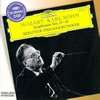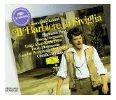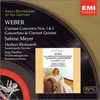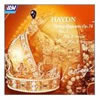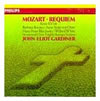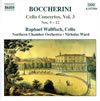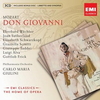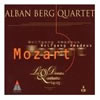|
Top 10 Classical Era CDs and MP3s for Your Classical Music Collection
What we now call the Classical period lasted from around 1730 until around 1810. The period's style arose as a reaction to the complexity of Baroque music. When compared to music of 50 years earlier, Classical music is much simpler. The complex counterpoint and elaborate ornamentation that are hallmarks of the Baroque era are minimized or even absent entirely in Classical compositions. A primary goal of Classical composers was to achieve balance: within phrases, within movements, and within compositions. The music is pleasant to the ear and while it is expressive, it avoids the over-the-top emotion that characterizes later Romantic music.
The three Classical composers that stand out over all the rest are Mozart, Haydn, and Beethoven. Since these three all worked in Vienna and influenced each other, their music has collectively come to be known as the "Viennese Classical Style." But Vienna was not the only musical center of this time: Luigi Boccherini and Gioachino Rossini flourished in Italy; Johann Sebastian Bach's sons Carl Phillip Emmanuel and Johann Christian were popular in Berlin and London, respectively; and François-Joseph Gossec composed symphonies and operas in Paris, just to name a few.
 Back to Eras Index Back to Eras Index
|
|
|
|
Vienna Philharmonic Orchestra, Carlos Kleiber, conductor
|
  |
|
|
|
Beethoven's Fifth is perhaps the most famous piece of classical music ever written, and deservedly so. The famous opening four note motif serves as the thematic material for the whole first movement, and it reappears in the third and fourth movements to make the symphony into a unified whole rather than a collection of four individual movements. This unity is apparent in other respects as well: the stormy opening movement is in a dark minor key, and the mood gradually shifts through the middle two pieces and culminates in a glorious brass fanfare that opens the finale. Carlos Kleiber's recording with the Vienna Philharmonic still stands as one of the all-time greats.
|
|
Similar works: Top 10 Beethoven, Top 10 Symphonies
|
|
|
|
| Vladimir Ashkenazy, piano and conductor; Philharmonia Orchestra |
  |
|
|
|
These two piano concertos combine orchestral brilliance with virtuosic solo work, making a splendid introduction to Mozart. The 20th, in a tragic minor key, moves from a dark and brooding beginning to an uplifting conclusion, and contains a memorable stormy outburst during an otherwise tranquil second movement. The beautiful middle movement of the 21st was used in the 1967 film Elvira Madigan and is one of Mozart's most famous pieces of music, while the finale brings the work to an exciting conclusion on a grand symphonic scale. Vladimir Ashkenazy is one of today's most versatile pianists and conductors, and he shows off both talents in this recording as he conducts from the keyboard. Ashkenazy makes the flurry of fast piano passages seem effortless while shaping the orchestra's sound perfectly. Best of all, these two concertos come with three more of Mozart's greatest concertos, all on two CDs for the price of one. |
|
Similar works: Top 10 Mozart, Top 10 Concertos
|
|
|
|
| Alfred Brendel, piano |
  |
|
|
|
While Beethoven's symphonies show outward storm and fire, the piano sonatas give us a more personal view of the composer. Beethoven composed his two most famous sonatas early in his career, when he was just making a name for himself in Vinna. The first movement of the "Moonlight" and the middle one of the "Pathétique" are so tender as to move the listener to tears. But the storm is not altogether missing; the "Pathétique" opening movement and the "Moonlight" finale contain some of Beethoven's most exciting music. Alfred Brendel gives a gripping performance on this two-disc set containing five other wonderful sonatas. |
|
Similar works: Top 10 Beethoven, Top 10 Piano
|
|
|
|
| Sylvia Stahlman, soprano; Helen Watts, alto; Wilfred Brown, tenor; Tom Krause, baritone; London Symphony Orchestra, Cambridge King's College Choir, David Willcocks, conductor |
  |
|
|
|
Franz Joseph Haydn is often cited as the "father of the symphony" and the "father of the string quartet," but his great sacred choral works are at least the equal of anything he wrote in a purely instrumental genre. Haydn wrote this mass in 1798 and gave it the title "Missa in Angustiis," or "Mass in Fear," which probably reflected the feelings of Haydn's fellow Austrians as Napoleon's armies were beginning their conquest of Europe. The mass acquired its more popular name after if was played for Lord Nelson, the hero of the Battle of the Nile, in 1800. Despite Haydn's ominous title, the mass expresses joy throughout, as it gloriously reaffirms Haydn's relationship with God. David Willcocks leads a superb cast of soloists in this recording that revolutionized the performance of Haydn's choral works. For an even more "authentic" feel, Trevor Pinnock's recording -- featuring instruments of Haydn's time -- is not to be missed. |
|
Similar works: Top 10 Haydn, Top 10 Choral
|
|
|
|
| Berlin Philharmonic Orchestra, Karl Böhm, conductor |
  |
|
|
These six symphonies are the last that Mozart wrote before his death at the tender age of 36, and they represent the pinnacle of the Viennese Classical style. The works demonstrate all the expressive possibilities of Mozart's music: the 35th is brimming with exuberance, while the 40th is dark and brooding, and the stately nature of the 41st led to its nickname of "Jupiter." In the final movement of the 41st, one hears different instruments entering right after each other with the same theme -- a technique Mozart had only recently acquired by studying the works of Bach. Karl Böhm was one of the great Mozart interpreters, and his Berlin Philharmonic Orchestra gives these works the gravity that they deserve.
|
|
Similar works: Top 10 Mozart, Top 10 Symphonies
|
|
|
|
| Takács String Quartet |
  |
|
|
|
If Beethoven's symphonies revolutionized the realm of orchestral music, his string quartets did no less to change the nature of chamber music. The string quartets of Mozart and Haydn, Beethoven's immediate predecessors, grew out of tradition of the divertimento, music intended for diversion or amusement and often played in the background. On the other hand, these three quartets, from Beethoven's so-called "middle period," are very serious affairs that command the listener's full attention. They have often been said to be symphonies in miniature, for Beethoven is able to coax as much emotion and sonority from four players as he is from a full orchestra. This recording demonstrates why Takács Quartet have emerged as today's leading interpreters of the Beethoven quartets. The playing is profound and technically impeccable, and the Takács make these quartets still sound fresh even after dozens of listenings.
|
|
Similar works: Top 10 Beethoven, Top 10 String Quartets
|
|
|
|
| Collegium Musicum 90, Richard Hickox, conductor |
  |
|
|
|
When Haydn traveled to England in 1791, he was hailed there as "the greatest composer in the world." He had been invited to compose and conduct a set of six symphonies for public performance, and he was determined that these works should live up to the advance billing. Indeed they did, and the British public were so grateful that he was asked to come back a few years later and write another set of six symphonies. The final two, Nos. 103 and 104, are Haydn's crowning achievements in the genre. They summarize everything Haydn had learned about the craft of composition, and they include some of the composer's most memorable melodies. The "Drumroll" symphony gets its name from the percussionist's part at the beginning, and is also notable for incorporating Croatian melodies remembered from Haydn's youth. The "London" symphony begins with a stately fanfare and then bursts into a sunny Allegro, and its final movement features a catchy folklike melody. Richard Hickox gives a sparkling performance on the CD which also includes the Symphony No. 95. |
|
Similar works: Top 10 Haydn, Top 10 Symphonies
|
|
|
|
| Teresa Berganza, mezzo soprano (Rosina); Luigi Alva, tenor (Almaviva); Hermann Prey, bass (Figaro); London Symphony Orchestra, Claudio Abbado, conductor |
  |
|
|
|
This innocent, playful, and charming opera is based on the first part of Beaumarchais’s Figaro trilogy. Newcomers will delight in the fact that the common childhood chant "Figaro Figaro Figaro" is in fact referring to this Figaro, the self-absorbed barber and servant to Count Almaviva. The opera tells the story of the wealthy Count, who has fallen in love with a commoner, Rosina, and chased her from Madrid to Seville. Disguised as the poor student Lindoro, the Count woos Rosina away from her ridiculously dim-witted guardian Doctor Bartolo and his accomplice Don Basilio. Through schemes and escapades of the Count proving his love for Rosina, the characters get in a mess of disguises, mistaken identities, and emotional entanglements. The lighthearted and youthful nature of the characters shines through the music, especially in Rosina’s aria "Una voce poco fa" and Figaro’s "Largo al factotum." Teresa Berganza gives a good portrayal of Rosina's part as Rossini wrote it, and the others in the cast sing well under Abbado’s attentive direction. For many years Rosina was sung by a soprano who could ornament the written part with higher notes, and Roberta Peters in this role brings a fine sparkle to Erich Leinsdorf's recording. |
|
Similar works: Top 10 Operas
|
|
|
|
| Sabine Meyer, clarinet; Dresden Staatskapelle, Herbert Blomstedt, conductor |
  |
|
|
|
Carl Maria von Weber lived at the crossroads of the Classical and Romantic eras. His opera Der Freischütz was the first great German Romantic opera, but the style of his clarinet concertos harkens back to an earlier era. The concertos require virtuosity but are not merely showpieces; indeed, had Mozart not written his masterpiece for clarinet, they would undoubtedly be the greatest works ever composed in the genre. |
|
Similar works: Top 10 Concertos
|
|
|
|
| Lindsay String Quartet |
  |
|
|
|
These quartets represent the pinnacle of Haydn's chamber writing, and demonstrate why Haydn deserves to be the "Father of the String Quartet" just as much as he is "Father of the Symphony." One of the most exciting is the second quartet, nicknamed "Fifths" from the musical interval that makes up the first movement's theme. The slow movement of the third quartet is a set of variations on the song "God Save Emperor Franz," which has since become the Austrian national anthem and also gives the quartet its nickname, "Emperor." The fourth quartet is nicknamed "Sunrise" after its introduction, which features a rising violin line. Though it has no nickname, the sixth is perhaps most inventive of them all, with a "Fantasia" slow movement that contains numerous harmonic surprises. The Lindsay Quartet are today's foremost Haydn interpreters, and their performances of these quartets demonstrate why this is so. |
|
Similar works: Top 10 Haydn, Top 10 String Quartets
|
|
|
|
| Barbara Bonney, soprano; Anne Sofie von Otter, alto; Hans-Peter Blochwitz, tenor; Willard White, bass; English Baroque Soloists, Monteverdi Choir, John Eliot Gardiner, conductor |
  |
|
|
|
As anyone who has seen the film Amadeus knows, Mozart was unable to complete his Requiem Mass before his death. (It is untrue, however, that he was poisoned by the rival composer Salieri.) The task of filling out the parts that Mozart had sketched and composing the entirety of the final four movements fell to his pupil Franz Xaver Süssmayr. Sussmayr did an admirable job, and the mass feels entirely like Mozart's work. If you think that all Mozart's music is light and fluffy, you should listen to this work -- it is one of the most grief-filled pieces ever written. The English Baroque Soloists and Monteverdi Choir attempt to recreate the performance conditions of Mozart's lifetime, and the result is a spectacular performance. |
|
Similar works: Top 10 Mozart, Top 10 Choral
|
|
|
|
| Raphael Wallfisch, cello; Northern Chamber Orchestra, Nicholas Ward, conductor |
  |
|
|
|
Though Luigi Boccherini never achieved the reknown of his German contemporaries, his music has a distinctive and attractive style. Various court appointments took him around Europe during his life, and he incorporated the music of each new place into his own style. He composed hundreds of works, primarily chamber music, but also symphonies, concertos, and operas. These cello concertos make for a pleasant hour of listening, and their price on the Naxos label makes them even more attractive. |
|
Similar works: Top 10 Concertos
|
|
|
|
| Eberhard Wächter, baritone (Don Giovanni); Giuseppe Taddei, baritone (Leporello); Elisabeth Schwarzkopf, soprano (Elvira); Dame Joan Sutherland, soprano (Anna); Philharmonia Orchestra and Chorus, Carlo Maria Giulini, conductor |
  |
|
|
|
Few operas are as closely tied with the life of the composer as Mozart's Don Giovanni. Written in the year of Mozart's father's death, Don Giovanni tells the story of a playboy hero-villain who must come to terms with himself and the ghost of a father figure, the Commendatore. Many scholars have speculated that Mozart represented his relationship with his father through Don Giovanni and the Commendatore. In the opera, Don Giovanni is a likable villain who woos innocent women only to break their hearts. His lowly servant Leporello is the unrewarded accomplice on all his conquests. The three main women, Donna Anna, Donna Elvira, and Zerlina, represent honor and goodness, and in the end they urge Don Giovanni to repent his sins. While the Commendatore's ghost is a threat to Don Giovanni, we soon discover that the biggest threat to the title character is himself. The opera's highlights include the duet "La ci darem la mano," and Leporello's aria cataloguing Don Giovanni's conquests. Carlo Maria Giulini's classic performance featuring superstars Elisabeth Schwartzkopf and Dame Joan Sutherland is the standard by which all subsequent recordings have been judged. |
|
Similar works: Top 10 Mozart, Top 10 Operas
|
|
|
|
| Cleveland Orchestra, George Szell, conductor |
  |
|
|
|
Beethoven's "Heroic" third symphony was originally dedicated to a contemporary revolutionary in a different field -- Napoleon Bonaparte. However, after Napoleon crowned himself emperor Beethoven stratched out the dedication and instead gave the symphony the title by which we know it today. Indeed, the symphony is one of heroic proportions. The first movement alone is nearly as long as most Mozart symphonies. The second movement is a tragic funeral march and is followed by a sprightly minuet. The finale is a set of variations that takes a simple theme and develops it in ever grander gestures. George Szell's performance is still electrifying more than forty years after it was recorded. |
|
Similar works: Top 10 Beethoven, Top 10 Symphonies
|
|
|
|
| Alban Berg Quartet |
  |
|
|
|
In 1782 Franz Joseph Haydn published his set of six string quartets, Op. 33, and they quickly became the rage of Vienna. At this time Haydn's mastery of the quartet genre was widely acknowledged, and Mozart set out to write a set of quartets emulating the style of the master. After a "long and laborious endeavor," Mozart completed this set of six string quartets in 1785 and dedicated them to Haydn. Together with Haydn's quartets of the period, they form the pinnacle of the Viennese quartet style. The Alban Berg Quartet's unsurpassed recording includes these six as well as Mozart's four last quartets. |
|
Similar works: Top 10 Mozart, Top 10 Chamber Music
|
|
|
|
|























